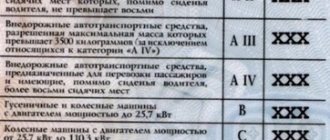Functionality of tachographs:
- registration of work and rest regimes of drivers transporting passengers and cargo by road in accordance with the requirements of the Labor Code of the Russian Federation;
- registration of vehicle speed, route and distance traveled;
- transfer of monitoring information to the dispatch center when using a GSM/GPRS communication module as part of the tachograph;
- registration and storage in the device’s memory of legally significant data about violations during the operation of the vehicle through the use of a cryptographic information protection device (CIPF unit) as part of the tachograph;
- prompt provision of reports (for a period of up to 365 days) by outputting data to a printing device included in the tachograph or providing information to inspecting authorities in the form of an electronic archive.
Description of the tachograph law
This law on tachographs was adopted by the State Duma on May 25, 2012 and approved by the Federation Council on June 6. In accordance with Federal Law, all vehicles transporting people, as well as trucks, must be equipped with tachometers. This rule applies to vehicles that have a total weight of more than three and a half, but not less than twelve tons.
The document consists of 2 chapters and 12 articles:
Chapter 1. Basic provisions of the law. Consists of the following articles:
- Article 1. Procedure for equipping vehicles with tachographs;
- Article 2. The procedure for applying the law on tachographs in relation to legal entities and individual entrepreneurs;
- Article 3. Procedure for equipping trucks with tachometers, with the exception of vehicles listed in the Order of the Ministry of Transport;
Chapter 2. Equipment of vehicles with tachographs. Includes the following articles:
- Article 4. List of trucks that must be equipped with tachographs;
- Article 5. Carrying out work to equip vehicles with special equipment;
- Article 6. Installation, activation, calibration, sealing of the technical mechanism;
- Article 7. Installation of equipment on a domestically produced vehicle;
- Article 8. Activation of the cryptographic information protection mechanism and block;
- Article 9. Implementation of calibration, after activating the tachograph and the CIPF unit;
- Article 10. Standards for printing a check indicating the required details;
- Article 11. Sealing procedure;
- Article 12. Re-calibration of the technical mechanism.
Federal Law No. 78-FZ of June 14, 2012 “On compulsory insurance of civil liability of the carrier for damage to life, health, property of passengers and on the procedure for compensation for such damage caused during the transportation of passengers by metro” was based on Order of the Ministry of Transport No. 273.
Last changes
The latest changes to the Federal Law on tachographs for trucks were made in 2020, which entered into legal force on January 1, 2020. In general, the innovations provide that this equipment is subject to metrological verification in a certain manner established by the legislation of the Russian Federation. Drivers are strictly prohibited from equipping a truck with an untested tachometer.
The following articles have been amended and supplemented:
Article 1
It was decided to add the following text to the first paragraph: “to equip vehicles with industrial control means that will provide continuous, uncorrected recording of information about the speed and route of the vehicle. Standards and requirements for tachographs, categories, types and procedures for their equipment are established in accordance with the Government of the Russian Federation.”
Check out the Mental Health Care Act
Article 7
The Law on Tachographs from January 1, 2020, stated Article 7 in the following wording: “Regulation of a vehicle for transportation and (or) passengers without technical means of supervision, violation of the work and rest regime by a person driving a vehicle for transportation and (or) passengers” .
The tachograph includes:
- on-board unit;
- tachograph cards (hereinafter referred to as cards);
- Motion Sensor;
- antenna for receiving signals from the global navigation satellite systems GLONASS and GPS (hereinafter referred to as GNSS);
- antenna for receiving and transmitting GSM/GPRS signals (if a communication module is included in the on-board device).
As well as a set of mounting parts for connecting tachograph components and installing them on a vehicle.
By order of the Ministry of Transport of Russia dated February 13, 2013. No. 36 defines a list of tachograph models installed on vehicles operated on the territory of the Russian Federation.
Requirements for tachographs in 2020:
- Vehicles on which digital recording devices with a cryptographic information protection module (NKM/CIPF) are installed are allowed to operate flights on the territory of Russia.
- To operate international flights (including within the EU), the vehicle must be equipped with an AETR tachograph.
The installed on-board device that records driving parameters must be connected to the speedometer and other sensors of the vehicle, sealed, calibrated and verified. Information about calibration/verification must be reflected in the documentation for the device. Smart tachographs planned for introduction in the EU must also meet certain standards:
- Connecting the device to a satellite navigation system.
- Possibility of transmitting data for control directly during the flight.
- The ability to connect a standard interface that allows you to output data from the tachograph to an external device in real time or with minimal delay.
Thus, the smart device ceases to serve as a simple recorder of vehicle movement parameters, but becomes one of the components of a global remote monitoring system.
Which tachograph is cheaper - a Russian one with cryptographic information protection or a European one according to the AETR?
- home
- " Question answer
At the moment, both Russian digital tachographs with a CIPF unit and, subject to certain conditions, European digital tachographs according to the AETR can be installed on vehicles in Russia. Let's try to figure out which is more profitable. We will consider a relatively modern car, with an electronic speedometer and a prepared place for installing a tachograph and a car service life of 6 and 9 years.
Russian tachographs with CIPF unit
initial costs:
- the cost of a tachograph is 35,000 rubles.
- activation of the CIPF block - 2,000 rubles.
- installation, connecting the tachograph to the speed sensor, connecting the speedometer to the tachograph, calibrating and setting up the tachograph - 5,000 rubles.
- setting up a tachograph - 2,000 rubles.
operating costs for 6 years:
- Periodic adjustment of the tachograph once every 3 years - 3000 rubles.
- replacement of the CIPF unit once every 3 years - 20,000 rubles.
The total cost of ownership for 6 years is 67,000 rubles. The total cost of ownership for 9 years is 90,000 rubles.
European tachographs
To install European tachographs in the Russian Federation, you must have a license for international transportation. The cost of obtaining a license in legal offices is 45,000–75,000 rubles. Duration: 30 days.
initial costs:
- the cost of a tachograph is 35,000 rubles.
- installing or replacing a conventional speed sensor with a magnetically protected sensor with KITAS 2+ encryption (if one is not installed by the manufacturer. On many cars, speed readings are taken from ABS sensors or from a conventional speed sensor, so when installing a tachograph you have to install a KITAS 2+ speed sensor ( AETR requirements)) - 5,050 rubles.
- activation, installation, calibration and configuration of the tachograph - 7,000 rubles.
- The European tachograph VDO 1381 does not have the ability to change the K coefficient (number of pulses per 1 km of track), you may have to install a speed pulse frequency converter - 2,300 rubles.
- According to AETR requirements, a second speed source must be connected to the tachograph. Unlike Russian tachographs, which have a GPS unit installed, the European tachograph connects to the car’s CAN bus, and if it is impossible to receive data from the CAN bus (this happens with Russian, American, Chinese cars), you need to install DTCO-Geoloc - 10,340 rubles .
operating costs for 6 years
- Periodic adjustment of the tachograph once every 2 years - 3,000 rubles.
The total RUB 65,690. without the cost of obtaining and renewing an international license. The total cost of ownership for 9 years is RUB 71,690. without the cost of obtaining and renewing an international license.
We considered the case with the maximum costs for preparing a car for operation with a tachograph according to the AETR rules. If you have a new European car, then additional installation of the KITAS 2+ speed sensor, speed pulse frequency converter, DTCO-Geoloc will not be required and then the cost of ownership will be reduced to 48,000 rubles. for 6 years and up to 54,000 rubles for 9 years.
You can see the overall result in the table. And make a conclusion about what type of tachograph to install on your company’s vehicles.
| CIPF | AETR with vehicle preparation | European car AETR | |
| initial costs | |||
| Tachograph | 35 000 ₽ | 35 000 ₽ | 35 000 ₽ |
| Sensor KITAS 2+ | not needed | 5 050 ₽ | installed |
| 2 speed source DTCO-Geoloc | not needed | 10 340 ₽ | CAN bus |
| Activation of the CIPF block | 2 000 ₽ | need not | need not |
| Installation, configuration | 7 000 ₽ | 7 000 ₽ | 7 000 ₽ |
| speed pulse converter | not needed | 2 300 ₽ | not needed |
| operating costs | |||
| Replacing CIPF once every 3 years | 20 000 ₽ | — | — |
| Tuning once every 3 years | 3 000 ₽ | — | — |
| Tuning once every 2 years | — | 3 000 ₽ | 3 000 ₽ |
| Total for 6 years | 67 000 ₽ | 65 690 ₽ | 48 000 ₽ |
| Total for 9 years | 90 000 ₽ | 71 690 ₽ | 54 000 ₽ |
A car with a Russian tachograph with a CIPF unit can ONLY be operated in Russia! With an AETR tachograph you can travel both in Russia and in the CIS countries and Europe.
The Trivi workshop carries out installation, activation and configuration of all types of tachographs. Phone for information.
You may also be interested in:
- Where can I install a tachograph?
- What is a driver card?
- In what cases is it necessary to replace the NKM (CIS) unit?
- What is tachograph setting?
- Which tachograph can I use?
Requirements for smart tachographs operating in the EU
European Union Regulation (AETR) 2016/799 was adopted on March 26, 2016 (entry into force on June 15) and contained requirements for equipping cars registered in the EU with second-generation devices - the so-called “smart tachographs”. An important feature of the regulations was that its key provisions came into force 3 years after adoption. Thus, by June 15, 2019, any vehicle registered for the first time in the European Union must be equipped with a smart tachograph. It is noted that:
- If a vehicle is registered in the European Union for the first time, it must be equipped with a control device that complies with the standards of regulation 2016/799.
- Vehicles currently in use in the EU must be equipped with devices whose design complies with the requirements of regulation 3821/85 (Appendices 1 and 1B).
- The period for mandatory re-equipment of all vehicles with the installation of new smart tachographs is no more than 15 years from the date of introduction of the current regulations (i.e. from June 2016).
In addition, the regulations require that keys and certificates for new generation recorders be available no later than 06/15/2018, workshop cards - no later than 03/15/2019. The issuance of all types of individual cards for new type devices will begin on May 15, 2019 in all EU member countries. The issue of integrating smart tachographs into the AETR agreement is still under discussion. Currently, Russian representatives have spoken out against this initiative, referring it to the competence of the UNECE.
List of regulatory documents on tachography:
1. Decree of the Government of the Russian Federation of November 23, 2012 No. 1213 “On the requirements for tachographs, categories and types of vehicles equipped with them, the procedure for equipping vehicles with tachographs, the rules for their use, maintenance and control of their operation”; 2. Federal Law of December 30, 2001 No. 197-FZ “Labor Code of the Russian Federation”. Ensuring uniform control (supervision) procedures throughout the entire territory of the Russian Federation over the work and rest regimes of drivers transporting passengers and cargo by road, taking into account the provisions of the European Agreement; 3. Order of the Ministry of Transport of the Russian Federation dated February 13, 2013 No. 36 “On approval of the requirements for tachographs installed on vehicles, categories and types of vehicles equipped with tachographs, rules for the use, maintenance and control of the operation of tachographs installed on vehicles”; 4. Decree of the Government of the Russian Federation of September 10, 2009 No. 720 “On approval of the technical regulations “On the safety of wheeled vehicles”; 5. Decree of the Government of the Russian Federation of December 17, 2013 No. 1177 “On approval of the Rules for the organized transportation of a group of children by buses”; 6. Order of the Ministry of Transport of the Russian Federation dated August 21, 2013 No. 273 “On approval of the Procedure for equipping vehicles with tachographs”; 7. Information letter to participants in the implementation of tachographic control on the territory of the Russian Federation “On the provision of additional information to the letter dated February 10, 2016 No. 08-02/363”; 8. Decision of the Supreme Court of the Russian Federation dated July 20, 2015 No. AKPI15-585; 9. Order of the Ministry of Transport of the Russian Federation dated May 21, 2012 No. 145 “On approval of the Procedure for issuing cards (cards) used in digital control devices installed on vehicles”; 10. Order of the Ministry of Transport of the Russian Federation dated 08/07/2018 No. 295 “On amendments to the Procedure for issuing cards (cards) used in digital control devices installed on vehicles, approved by Order of the Ministry of Transport of the Russian Federation dated May 21, 2012 No. 145 " (Registered 01/17/2019 No. 53403); 11. Code of Administrative Offenses, No. 195-FZ | Art. 11.23 Code of Administrative Offenses of the Russian Federation; 12. Order of the Ministry of Transport of the Russian Federation dated July 26, 2017 No. 277 “On amendments to the orders of the Ministry of Transport of the Russian Federation dated August 21, 2013 No. 273 “On approval of the Procedure for equipping vehicles with tachographs” and dated February 13, 2013 No. 36 “On approval requirements for tachographs installed on vehicles, categories and types of vehicles equipped with tachographs, rules for use, maintenance and control of the operation of tachographs installed on vehicles”; 13. EU Regulation No. 2016/799 of 18 March 2020
New Tachograph Law
Order of the Ministry of Transport No. 273 dated August 21, 2013, as amended by Order No. 348 dated December 2, 2015 “On approval of the Procedure for equipping vehicles with tachographs” for truck owners is the law. On July 1, 2020, a tachograph must be installed on all cargo and passenger vehicles of the categories described below. At the same time, the use of analog control devices (the so-called “puck”) has been illegal since July 1, 2016. A digital tachograph should be installed. The new provisions have already entered into force, so you should take a closer look at this issue.
Service workshop of JSC "ENDS"
Offers services for installation, testing, maintenance and repair of Russian (RF230) and European (RUS462) tachographs. Attention:
if you or your company are planning to select, purchase and install tachographic equipment, the service workshop of JSC "ENDS" will help you quickly and efficiently equip the vehicle in accordance with the requirements of current regulations.
Installation of a tachograph with a cryptographic information protection unit, purchase of tachograph cards
Contacts
302020, Orel, Vesyolaya 1
Tel./fax, ext. 116
Tel. mob.
Email:
Internet address:









